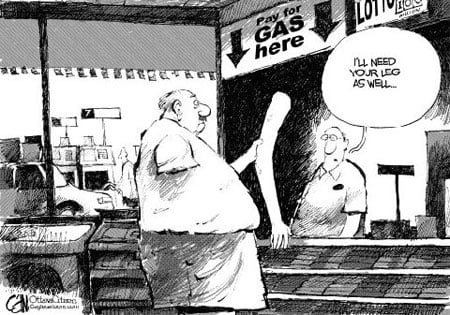
As you are reading this, the Cabinet Commitee on Inflation meeting regarding our country’s fuel subsidy system has already been running for about more than half an hour. The results of this meeting will be announced possibly later today and be implemented starting from tomorrow, according to the PM. There has been a few updated bits and piece of info released by the media today, hinting at what the final restructured fuel subsidy plan will be. Here is what we know at the moment:
- The government is currently studying two methods of delivering subsidies – based on cash income and based on quota. What has been repeated many times in the past is that those who can afford to pay market rates should pay for them so I think we can assume that subsidies based on cash income is a go, but the question here is whether those who qualify for subsidies will have a quota set on how much subsidies they can enjoy. I think quotas make sense to prevent someone with subsidies to profit from selling subsidised fuel on the black market to those who do not qualify for subsidies. Someone with low income should also get just enough subsidies for the bare necessities of commuting, this is to discourage wastage of subsidised fuel.
- The PM wishes for the new subsidy structure to be implemented from tomorrow onwards, but I think we can realistically see it some of it implemented tomorrow and the rest in stages leading towards a full implementation in August.
- There will also be no controlled prices for fuel in August 2008 onwards. This means that the market price will be determined by the fuel companies. This could also lead to different stations offering different prices for fuel.
- We still do not know whether fuel tax will be added to the market price for petrol As a higher market price is already a big shocker for most people, what I think is that the initial market price will not have fuel tax, but fuel tax may be added later.
- The ban at the northern border preventing foreign cars from filling up is now in effect, with the Singaporean border ban to be applied later. This ban only affects cars. Foreign-registered motorcycles can still fill up their fuel unrestricted.
UPDATE 3:37PM: Domestic Trade and Consumer Affairs Minister Datuk Shahrir Samad says that the full new subsidy system cannot be decided immediately, so only initial details will be announced tomorrow, with the full picture to be unveiled in August 2008. He also added that the fuel subsidy mechanism could involve the following methods: a) cash income subsidies b) quota system tied to MyKad or car registration number.
With this latest piece of news, a market price at pump for petrol may not be introduced from Wednesday onwards as previously indicated. The market price is likely to be truly insane compared to what we are used to – in the high RM3 range, close to RM4 per litre.
UPDATE 8:15PM: Buletin Utama TV3 mentioned that according to calculations using a crude oil price of USD130 a barrel, the market price for a litre of RON97 petrol would be RM3.12, and this would not include a potential fuel tax.
Looking to sell your car? Sell it with Carro.


AI-generated Summary ✨
Comments express frustration over the fuel subsidy removal and its impact on cost of living, especially for middle and lower-income groups, highlighting concerns about rising fuel, car prices, and overall inflation. Many are skeptical about government transparency and how the savings from removing subsidies will be used, questioning whether funds benefit the rakyat or cronies. Several suggest alternative solutions such as improving public transportation, reducing tolls, and encouraging hybrid or electric vehicles. Others criticize high car taxes and import duties, comparing Malaysia unfavorably to neighboring countries, and emphasize the need for long-term planning rather than short-term fixes. Overall, sentiments reflect disappointment with government policies, concern over economic burden, and a desire for fair distribution of resources and benefits.